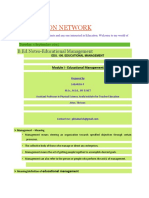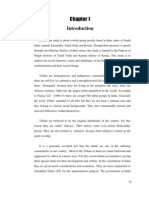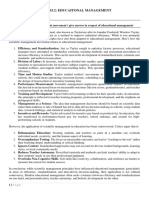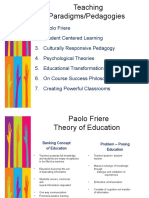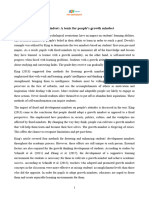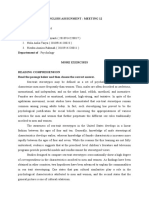Unit I - Introduction To Value Education
Unit I - Introduction To Value Education
Uploaded by
mayukhabhiCopyright:
Available Formats
Unit I - Introduction To Value Education
Unit I - Introduction To Value Education
Uploaded by
mayukhabhiOriginal Description:
Original Title
Copyright
Available Formats
Share this document
Did you find this document useful?
Is this content inappropriate?
Copyright:
Available Formats
Unit I - Introduction To Value Education
Unit I - Introduction To Value Education
Uploaded by
mayukhabhiCopyright:
Available Formats
Unit I - Introduction To Value Education
Topic: Understanding Value Education
Character oriented education that instills basic values and ethnic values in one’s psyche is
called ‘value based education’.
One definition refers to it as the process that gives young people an initiation into values,
giving knowledge of the rules needed to function in this mode of relating to other people, and to
seek the development in the student a grasp of certain underlying principles, together with the
ability to apply these rules intelligently, and to have the settled disposition to do so.
Significance of Value Education
Value education is important to help everyone in improving the value system that he/she
holds and puts it to use.
Once, one has understood his/ her values in life he/she can examine and control the
various choices he/she makes in his/ her life.
One has to frequently uphold the various types of values in his/ her life such as cultural
values, universal values, personal values and social values.
Value education is always essential to shape one’s life and to give one an opportunity of
performing on the global stage.
The need for value education among the parents, children, teachers etc, is constantly
increasing as we continue to witness increasing violent activities, behavioral disorders and
lack of unity in the society etc.
Value education enables us to understand our needs and visualize our goals correctly and
also indicate the direction for their fulfillment. It also helps remove our confusions and
contradictions and enables us to rightly utilize the technological innovations.
Human Values:
Human values are a set of emotional rules; people follow to make the right decisions in
life.
When values are used in a professional setting, they are called ethics.
Values are used in every day decision making at work and at home.
Good values instill a sense of integrity, honesty and diligence in people.
Without good values, people would become corrupt, dishonest and undependable as
people and employees.
Cultural Values:
Groups, societies and cultures have values that are largely shared by their members.
The values identify those objects, conditions or characteristics that members of the
society consider important; that is, valuable.
In the western world, for example, values might include material comfort, wealth,
competition, individualism or religiosity.
Ms SONAM KAPIL Asst. Professor MIT MEERUT UNIT 1 Page 1
The values of a society can often be identified by noting which people receive honour or
respect.
In the US, for example, professional athletes at the top levels in some sports are honored
(in the form of monetary payment) more than college professors.
Values are related to the norms of a culture, but they are more general and abstract than
norms. Norms are rules for behavior in specific situations, while values identify what
should be judged as good or evil.
Example: Flying the national flag on 15th August in India is a norm, but it
reflects the value of patriotism.
Wearing dark clothing and appearing solemn are normative behaviours at the
funeral. They reflect the values of respect and support of friends and family.
Different cultures reflect different values. “Over the last three decades, traditional-age
college students have shown an increased interest in personal well-being and a
decreased interest in the welfare of others.” Values seem to have changed, affecting
the beliefs, and attitudes of college students.
Purpose of Value Education
The Role of Value Education:
Value education plays a very important role in creating a better society, more ethical
organizations and groups, and better human beings as:
1. Value education can help to build human beings who possess strength, integrity and
fortitude based upon ancient Indian values.
2. Value education builds the values of cooperation and peace as well as tolerance.
3. Efficiency can step up if a person possesses the right values. This may include punctuality,
keeping one’s word, professionalism, lack of bias or prejudice etc.
Ms SONAM KAPIL Asst. Professor MIT MEERUT UNIT 1 Page 2
4. Creating cordial relationships between people by encouraging the values of respect, love
and affection.
5. Promoting personality development and social cohesion.
6. Regeneration values of national pride and integration towards nation- building.
7. Building character in the young people who will lead the country in the future.
8. Inculcate moral and spiritual values in the minds of students and making them aware of
the teachings of Great Men so that they may learn from their examples.
9. Promoting harmony between nations and creating a peaceful world order.
10. Identifying the core universal values of:
a. Truth (Satya)
b. Righteous Conduct (Dharma)
c. Peace (Shanti)
d. Love (Prema)
e. Non-Violence (Ahimsa)
11. To help create a foundation of the quality of life and strike a balance between external and
internal values.
Thus value education can play a significant role in the betterment of individuals, groups
and society at large. This is shown in the figure below:
Need of Value Education
Correct identification of our aspirations. The subject which enables us to understand ‘what
is valuable’ for human happiness is called ‘value education’ (VE). Thus, VE enables us to
understand our needs and visualize our goals correctly and also indicate the direction for
their fulfillment. It also helps to remove our confusions and contradictions and bring
harmony at all levels.
Understanding universal human values to fulfill our aspirations in continuity. All
human beings continuously aspire for a happy life, successful life, and the purpose of
education is to provide adequate competence to actualize this aspiration.
Complementarity of values and skills. For this it is essential to understand – what is really
‘valuable’ for human being, and what is really conductive to a happy and fulfilling life? -
This is the ‘value domain’.
Ms SONAM KAPIL Asst. Professor MIT MEERUT UNIT 1 Page 3
Then one should know – how to actualize it? How to make it happen? – This is the
‘domain of skills’.
Hence, there is an essential complementarity between values and skills for the success of
any human endeavor.
For example, I want to lead a healthy life. Only wishing for good health will not help me
keep my body fit and healthy and without having understood the meaning of health, I will not
be able to choose things correctly to keep my body fit and healthy.
Evaluation of our beliefs. Each one of us believes in certain things and we base our values
on these beliefs, are they false or true which may or may not be true in reality. VE helps us to
evaluate our beliefs and assumed values.
Technology and human values. The present education system has become largely skill-
based. The prime emphasis is on science and technology. However, science and technology
can only help to provide the means to achieve what is considered valuable. It is not within the
scope of science and technology to provide the competence of deciding what really is
valuable.
VE is a crucial missing link in the present education system. Because of this deficiency, most
of our efforts may prove to be counter-productive and serious crises at the individual, societal
and environmental level are manifesting.
Hence, there is a strong need to rectify this situation
Basic Guidelines for Value Education
In order to qualify for any course on value education, the following guidelines for the
content of the course are important:
Universal: It needs to be applicable to all the human beings irrespective of cast, creed,
nationalities, religion, etc., for all times and regions.
Rational: It has to appeal to human reasoning.
Natural and verifiable: It has to be naturally acceptable to the human being who goes
through the course and there needs to be every provision in nature for its fulfillment. It needs
to be experientially verifiable, and not based on dogmas, beliefs or assumptions.
All encompassing: It needs to cover all the dimensions (thought, behavior, work and
realization) and levels (individual, family, society, nature and existence) of human life and
profession.
Leading to harmony: The value education ultimately is targeted to promote harmony within
the individual, among human beings and with nature.
Types of Values
Life comes with its ups and downs. Yes, we all know that. But there are certain mindsets
that affect our life for the better and some that affect it for the worst. These mindsets that
affect our life for the better can be called as values.
Whilst it stands true that all people have different values in life, there are some important
values in life that should be considered by all. Not because these are the values that we
follow, but because it could truly make this world a better place.
Ms SONAM KAPIL Asst. Professor MIT MEERUT UNIT 1 Page 4
Most Important Core values in life:
Love : Unconditional & unselfish care
Discipline/truth/honesty: Indispensible ethical discipline
Non Violence: Means respect for life and recognition for rights for others
Right conduct: Truth in action is right conduct
“Thinking with love is truth, feeling with love is peace, acting with love is right conduct,
and understanding with love is non-violence”
Ms SONAM KAPIL Asst. Professor MIT MEERUT UNIT 1 Page 5
Process of Value Education
The process for value education has to be that of self-exploration, and not of giving sermons
of telling dos and don’ts. Whatever is found as truth or reality may be stated as a proposal
and every student is to be encouraged to verify it on his/ her own right.
This process of self-exploration has to be in the form of a dialogue- a dialogue between the
teacher and students to begin with and within the student finally.
Topic : Self Exploration
Self exploration is the process to find out what is valuable to me by investigating within
myself, what is right for me, true for me, has to be judged within myself. Through self
exploration we get value of myself.
Meaning and Purpose of Self Exploration:-
1. It is a process of dialogue between “what you are” and “what you really want to be”: It
is a process of focusing attention on our-self, our present beliefs and aspirations vis-à-vis
what we really want to be (that is to say, what is naturally acceptable to us). It is a process of
discovering that there is something innate, invariant and universal in all human beings. This
enables us to look at our confusions and contradictions within and resolve them by becoming
aware of our natural acceptance.
2. It is a process of self-evaluation through self investigation: It successively enables us to
evolve by bridging the gap between ‘what we are’ and ‘what to be’.
3. It is a process of knowing oneself and through that, knowing the entire existence: The
exploration starts by asking simple questions about ourself, which gives our clarity about our
being, and then clarity about everything around us.
4. It is a process of recognizing one’s relationship with every unit in existence and
fulfilling it: It is a process of becoming aware about our right relationship with other entities
in existence and through that discovering the interconnectedness, co-existence and other in
the entire existence, and living accordingly.
5. It is a process of knowing human conduct, human character and living accordingly: It is
a process of discovering the definitiveness of human conduct and human character and
enabling one to be definite in thought, behavior and work.
6. It is a process of being in harmony in oneself and in harmony with entire existence: This
process of self exploration helps us to be in harmony with ourself and with everything
around.
Ms SONAM KAPIL Asst. Professor MIT MEERUT UNIT 1 Page 6
7. It is a process of identifying our innateness and moving towards self organization and
self-expression: This process of self exploration helps us to identify our swatva and through
that acquiring swantantrata and swarajya.
Swatva: Innateness of self – the natural acceptance of harmony
Swatantrata: Being self- organized – being in harmony with oneself
Swarajya: Self-expression, self- extension – living in harmony with others
Swatva Swatantrata Swarajya
The swatva is already there, intact in each one of us. By being in dialogue with it, we
attain swantantrata enabling us to work for swarajya.
Content of Self Exploration
1. The Desire/Goal: What is my (human) Desire/ Goal?
2. Program: What is my (human) program for fulfilling the desire?
The main focus of self-exploration is myself- the human being. Basically, it should dwell
on the following two key questions:
1. What do I really want in life, or what is the goal of human life?
2. How to fulfill it? What is the program to actualize the above?
In short, the above two questions cover the whole domain of human aspirations and
human endeavour. Thus, they form the content of self- exploration.
Process of Self Exploration
1. Whatever is being presented is a PROPOSAL.
Don’t assume it to be true immediately, nor reject it without proper exploration.
Verify it in your own right, on the basis of it being naturally acceptable to you,
o Not just on the basis of scriptures
o Not on the basis of equipment/instrument data
o Not on the basis of the assertion by other human beings.
Therefore, it is essential to carefully ponder over these on your own right. Neither accept
these as true immediately nor reject them prematurely without proper exploration.
Don’t just accept / reject these only on the basis of the following:
Because something like this/ different from this, has been mentioned in scriptures,
Or, because it has been preached/ denied by some great men,
Or, a large number of people possess such a view / a different view,
Or it is claimed to have been verified through some physical instrument or, claimed that
this is beyond the domain of verifiability by physical instruments.
Then what to do
2. Verify on the basis of your natural acceptance
3. Live accordingly to validate it experientially
o If the proposal is true in behaviour with human leads to mutual happiness
o If the proposal is true in work with rest of the nature leads to mutual prosperity
4. Results in realization and understanding
5. On having realization and understanding we get
a. Assurance
b. Satisfaction
Ms SONAM KAPIL Asst. Professor MIT MEERUT UNIT 1 Page 7
c. Universality (Applies to all time space and individual)
Remember, it is a process of self- exploration, therefore, it has to be authenticated by you
alone by means of verification at the level of natural acceptance and experiential validation. The
process is shown in the diagram below
Take for example: a proposal- ‘respect’ is a value in human relation. When I verify at the
level of natural acceptance, I find that it is naturally acceptable to me. Similarly, when I behave
with respect, it is mutually fulfilling to me and to the other.
Thus the proposal is ‘True’. If it fails on any of the two tests, it is untrue.
This verification leads to realization of the truthfulness of the proposal and it becomes
part and parcel of my understanding. It is reflected in my thoughts and in my behavior.
- 1.It is a proposal Process of Self Exploration
o Don’t assume it to be true
o Verify it in your own right
Not on the basis of scriptures
Not on the basis of readings from instrument
Not on the basis of others
- Self verification
3.live according to
Proposal
2.Verify on the basis behaviour with work with rest of the
of your natural human leads to nature leads to mutual
acceptance mutual happiness prosperity
4. Result in
Realization and Assurance
Understanding 5.Test Satisfaction
Universality
Time Space Individual
Mechanism of Self Exploration
If one can explore and understand the self in such a manner that he/she grasps the essence
of the self there may never need to be any reason for psychological help at a large stage. The two
mechanisms for self exploration may be identified as;
Natural Acceptance, and
Experiential Validation.
Natural Acceptance:
Natural acceptance implies unconditional and total acceptance of the self, people
and environment. It also refers to the absence of any expectations from others. Once you fully
and truly commit yourself on the basis of natural acceptance, you feel a holistic sense of inner
harmony, tranquility and fulfillment.
Actually natural acceptance is way to accept the good things naturally. Learn everything
that is good from others, but bring it in, and in your own way absorb it; do not become others.
In other words natural acceptance is process understand yourself first. Try to find out the
ego stage. Try to reduce that. Open your eyes and look around. The world is full of good things.
Ms SONAM KAPIL Asst. Professor MIT MEERUT UNIT 1 Page 8
You need to accept the right naturally. Once it starts coming naturally, you will feel that you are
actually upgraded yourself and now you are above then the rest of the world. Problems are the
part of life and natural acceptance is the answer of that.
Characteristics of natural acceptance:-
1. Does not change with time.
2. Does not depend on places.
3. Does not depend on beliefs or past conditionings.
4. This natural acceptance is ‘constantly there’ something can refer to. It is telling us what is
right.
5. It is same for all of us. It is part and parcel of every human being, it is part of humanness.
Experiential Validation:
Experiential validation is a process that include direct experience with the learning
environment and content. It may be regarded as a philosophy and methodology in which the
direct experience and focused reflection of the individual helps to increase knowledge, develop
skill and clarify values.
We are often told to accept ourselves for who we are. What we know about our self is not
through our own opinion but also on how others view us. When our beliefs comes to be true/
validated by some situations, phenomena or outcomes. We may term it as experiential validation.
What is our State Today in self exploration?
Today, we are not oriented enough to evaluate our beliefs or assumptions and we treat
them as our personal life. We generally keep them secure in the name of personal life and
freedom. We usually become very sticky about them without really verifying them. When these
come in conflict, we try hard to search out justifications and make all efforts to defend our own
assumptions. In the process, we cheat us ourselves as well as others.
What is the Way Out? What Do We Need To Do?
Realization and Understanding:
As we continue with the process of verification of proposals on the basis of our natural
acceptance and test it out in our living, it ultimately results in realization and understanding in us.
The answer we get should be assuring, satisfying and universal. Universal means the
answer should be same for everyone. They are invariant with respect to time, space and
individual. If the answers we get do not fulfill any of the criteria it means the answer is most
likely coming from our past beliefs/conditioning and not from our natural acceptance.
Ms SONAM KAPIL Asst. Professor MIT MEERUT UNIT 1 Page 9
Topic : Basic Human Aspirations – Continuous Happiness
and Prosperity
Basic Human aspiration:
We desire for many things in this world, say materialistic needs, respect, recognition, love, trust
etc, but in the form of all these we aspire for true and continuous happiness and prosperity.
(i) Happiness
Happiness is a state of mind or feeling characterized by love, satisfaction, pleasure or joy.
Happiness may be described as consisting of positive emotions and positive activities.
Happiness may be defines as being in harmony/ synergy in the state/ situation that I live in . “A
state or situation in which I live in , if there is harmony in it then I like to be in that state/
situation. The state of liking is happiness.”
In other words:
It is a freedom from want and distress
Consciousness of the good order of things
Assurance of one’s place in the universe or society
Inner peace.
Happiness is the state of mind, where we feel good in most of the walk of life.
Philosophers and religious thinkers often define happiness in terms of living a good life; or
flourishing, rather than simply as an emotion.
(ii) Prosperity
Prosperity is the state of flourishing, thriving, success or good fortune. Prosperity
often encompasses wealth but also includes other factors which are independent of wealth
to varying degrees, such as happiness and health.
The word means the sum of three aspects – health, wealth and wisdom.
Ms SONAM KAPIL Asst. Professor MIT MEERUT UNIT 1 Page 10
Prosperity is the state of enlightenment towards better life and towards the happy society.
Difference between prosperity and wealth
Wealth is a physical thing. It means having money or having a lot of physical facilities or both.
Prosperity is a feeling of having more than required physical facilities. (Note: all our physical
facilities are directly or indirectly depend on nature, the continuity of our prosperity can be
ensured only if our production systems are in harmony with the nature. It means using natural
resources in a renewable manner and utilizes appropriate technologies so that human needs are
satisfied and nature is also enriched).
Presently, as we look around, we find most of the people in the following two
categories
To achieve our basic aspiration we need to work for right understanding as the base to which we
can work for relationship and then physical facilities. Today we are not working accordingly to
this that why we can see that there are two kinds of people in the world.
1. Those that do not have physical facilities / wealth and feel unhappy and deprived i.e.
SVDD Sadhan Viheen Dukhi Daridra- Materially deficient , unhappy and deprived
2. Those that have physical facilities /wealth and feel unhappy and deprived i.e. SSDD
Sadhan Sampan Dukhi Daridra- Meterially affluent ,unhappy and deprived
But these are states we don’t want to be in. We want to move from this to third category i.e.
3. Having physical facilities and feeling happy and prosperous i.e. SSSS Sadhan Sampann
Sukhi Samriddha – Materially adequate , happy and prosperous.
Ms SONAM KAPIL Asst. Professor MIT MEERUT UNIT 1 Page 11
Presently , as we look around , we found most of the people in the above two categories called
SVDD & SSDD , while the natural acceptance of all human being is to be in the categories of
SSSS.
Requirements for Fulfilling the Basic Aspirations
The basic requirements for fulfilling the aspirations of every human being are:
Right Understanding: This refers to higher order human skills – the need to learn and
utilize our intelligence most effectively.
Good Relationships: This refers to the interpersonal relationships that a person builds in his
or her life – at home, at the workplace and in society.
Physical Facilities: This includes the physiological needs of individuals and indicates the
necessities as well as the comforts of life.
We can say that these requirements are patterned on the lines of the hierarchy of needs.
(Abraham Maslow has given the concept of the hierarchy of needs. According to him there are
five needs which can be placed in a hierarchy depending on which needs a person initially strives
to fulfill. The lowest needs are the physiological needs. Once these are fulfilled, they are
followed by safety and security needs. These are followed by social needs. The next level of
needs relates to the person’s need for self-esteem. The highest order need relates to the need of
self-actualization and will only become important if all the other needs are fulfilled.)
How physical facilities are necessary but not complete for human beings.
Animal Consciousness and Human Consciousness
Giving all priorities to physical facilities only, may be termed as ‘Animal consciousness’
For animal, physical facility is necessary as well as complete – whereas for human beings it
is necessary but not complete.
Working only for physical facilities is living with Animal Consciousness.
Working for right understanding as the first priority followed by relationship and physical
facilities implies living with Human Consciousness.
There is a need for transformation from Animal Consciousness to Human Consciousness.
It can be accomplished only by working for right understanding as the first priority.
Ms SONAM KAPIL Asst. Professor MIT MEERUT UNIT 1 Page 12
This transformation from Animal Consciousness to Human Consciousness forms the basis
for human values and values based living.
We can verify this by a set of proposals.
“Physical facilities are necessary for human beings.”
“Physical facilities are necessary for human beings and they are necessary for animals.”
“Physical facilities are necessary and complete for animals, while they are necessary but not
complete for humans.”
For Animals: Animals need physical things to survive, mainly to take care of their body.
For Humans: While physical facilities are necessary for human beings, they are not complete by
themselves to fulfill our needs. Our needs are more than just physical facilities;
Besides physical facilities, we want
Relationship:
By relationship, we mean the relationship we have with other people, or human beings;
father, mother, brother and sisters, our friends, our teachers; we desire good relationships with all
of them.
In Relationship we want:
Mutual Fulfillment: If there is a problem in relationship, we feel uneasy, it bothers us. Even if
we are interacting with someone, and something we said or did offends them, it makes us
uneasy; i.e. we want mutual fulfillment in relationship.
Ms SONAM KAPIL Asst. Professor MIT MEERUT UNIT 1 Page 13
In Physical Facilities we want:
Prosperity in us, Enrichment in Nature: Prosperity means the feeling of having or being able
to have more physical facilities than is needed. If we don’t have the feeling of prosperity we will
exploit others. Similarly as we interact with nature for our various physical needs, either exploit
nature or enrich it. But our natural acceptance is that we want to live in harmony with nature.
What is Our State Today in Human Aspiration?
In Relationship
We are unable to have fulfilling relationships all the time: in family, outside family, and
as a society – in the world at large.
In Physical Facilities
We want to feel prosperous, but end up working only for accumulation of wealth. We
want to enrich nature, but are exploiting it, destroying it.
Ms SONAM KAPIL Asst. Professor MIT MEERUT UNIT 1 Page 14
Why we are in This State? – Living with Wrong Assumptions
What is the Outcome of the Misconception?
At the level of individual– Rising problems of depression, anxiety, suicides, stress,
insecurity, increasing health problems, lack of confidence and conviction etc.
At the level of family– Breaking up of joint families, mistrust and disharmony in
relationships, divorce, generation gap, dowry deaths, neglect of older people etc.
At the level of society– Growing incidences of terrorism, violence, communalism, racial
and ethnic struggle, corruption, adulteration, sex-crimes exploitation, wars between nations,
proliferation of lethal weapons etc.
At the level of nature– Global warming, weather imbalances, depletion of mineral and
energy resources, deforestation, soil degradation etc.
All the problems are a direct outcome of an incorrect understanding, our wrong notion
about happiness and prosperity and their continuity – this is an issue for serious exploration.
What is the way out?
What is the Solution? – The Need for Right Understanding
In order to resolve the issues in human relationships, we need to understand them first,
and this would come from ‘right understanding of relationship’.
Similarly in order to be prosperous and to enrich nature, we need to have the ‘right
understanding’. The ‘right understanding’ will enable us to work out our requirements for
physical facilities and hence correctly distinguish the difference between wealth and prosperity.
With nature as well, we need to understand the harmony in nature, and how we can complement
this harmony.
Ms SONAM KAPIL Asst. Professor MIT MEERUT UNIT 1 Page 15
You might also like
- Mary Kempen Quiz On Co TeachingDocument4 pagesMary Kempen Quiz On Co Teachingapi-264464926100% (1)
- Assure Model Atanu Nandi, M.Ed Trainee, Session 2018-20 Gangadharpur Sikshan MandirDocument4 pagesAssure Model Atanu Nandi, M.Ed Trainee, Session 2018-20 Gangadharpur Sikshan MandirAtanu NandiNo ratings yet
- Selection Criteria NEWDocument2 pagesSelection Criteria NEWJaehyuk Lee100% (1)
- Annotated BibliographyDocument4 pagesAnnotated Bibliographyapi-344094647100% (1)
- Unit I - Introduction To Value EducationDocument77 pagesUnit I - Introduction To Value EducationHarpreet Singh Burmi100% (1)
- Value Education: Delhi Technological UniversityDocument7 pagesValue Education: Delhi Technological UniversitySOURAV KUMARNo ratings yet
- Rashtriya Madhyamik Shiksha Abhiyan (RMSA)Document6 pagesRashtriya Madhyamik Shiksha Abhiyan (RMSA)anju clNo ratings yet
- Education SystemDocument41 pagesEducation Systemshiv2info_193797132100% (1)
- Comparism of Objective of Social Studies of Nigeria and GhanaDocument3 pagesComparism of Objective of Social Studies of Nigeria and Ghanakyrian chimaNo ratings yet
- MainstreamingDocument13 pagesMainstreamingShellsia St JusteNo ratings yet
- Educ 160502142410Document51 pagesEduc 160502142410Mon Eldrid RamosoNo ratings yet
- Teacher's Role in Value Education and Educational Management of An InstitutionsDocument8 pagesTeacher's Role in Value Education and Educational Management of An Institutionsbmerf indiaNo ratings yet
- Article ReviewDocument8 pagesArticle ReviewLau Lee LingNo ratings yet
- Module 2. TTPDocument12 pagesModule 2. TTPcesar pabilonaNo ratings yet
- Values of Teaching MathematicsDocument10 pagesValues of Teaching MathematicsaniNo ratings yet
- Education in Pakistan A1Document10 pagesEducation in Pakistan A1فہد احمدNo ratings yet
- Contemporary India and Education Unit 2Document17 pagesContemporary India and Education Unit 2PriyaNo ratings yet
- Desirable Behaviour For The Instructional SkillsDocument12 pagesDesirable Behaviour For The Instructional Skillsjohnmark2789No ratings yet
- 6th Grade - Addie ModelDocument11 pages6th Grade - Addie ModelRenChui SuNo ratings yet
- District Primary Education ProgrammeDocument4 pagesDistrict Primary Education ProgrammeSajid AnsariNo ratings yet
- Introduction To Sociology of EducationDocument29 pagesIntroduction To Sociology of EducationNurul Asnur Farahin Mannan100% (1)
- School ManagementDocument39 pagesSchool ManagementArvind Tikote67% (3)
- Read NCF 2005 and NCFSE 2023 in Context To Social Science and Prepare A Report On Changes in The CurriculumDocument2 pagesRead NCF 2005 and NCFSE 2023 in Context To Social Science and Prepare A Report On Changes in The Curriculumsonuvijay5205No ratings yet
- 16,32,34 - Teacher Accountability Unit 1 Part BDocument19 pages16,32,34 - Teacher Accountability Unit 1 Part BPriya SinghNo ratings yet
- Value Oriented EducationDocument10 pagesValue Oriented EducationMUJEEB RAHIMAN KATTALINo ratings yet
- Final Research - Chapter 1-5Document72 pagesFinal Research - Chapter 1-5leslie Joy EsculturaNo ratings yet
- Implementing Right To Education: Issues and ChallengesDocument7 pagesImplementing Right To Education: Issues and ChallengespkvlaserNo ratings yet
- Syllabus For Educational Courses in Integrated BED VBU Hazaribag PDFDocument112 pagesSyllabus For Educational Courses in Integrated BED VBU Hazaribag PDFRajeev Ranjan100% (1)
- 1Document13 pages1priyankaNo ratings yet
- Paniyas of WayanadDocument18 pagesPaniyas of WayanadMohammed ArshadNo ratings yet
- EDU 38 Unit 2.1 2.5Document32 pagesEDU 38 Unit 2.1 2.5Norlyn CuntapayNo ratings yet
- Impact of Economic and Cultural Differences in SocializationDocument7 pagesImpact of Economic and Cultural Differences in SocializationD.A ChasieNo ratings yet
- Equity and Excellence: Glimpses From Secondary Education of IndiaDocument9 pagesEquity and Excellence: Glimpses From Secondary Education of Indiadeepti sharmaNo ratings yet
- Merits & Demerits of Islamic EducationDocument4 pagesMerits & Demerits of Islamic EducationkumtinupongenNo ratings yet
- Discussing The Importance of Teaching Ethics in Education PDFDocument4 pagesDiscussing The Importance of Teaching Ethics in Education PDFMELISSA DAVILA CHAVEZ0% (1)
- Sociological Basis of EducationDocument2 pagesSociological Basis of EducationHoney Kate ConcepcionNo ratings yet
- A Study On Parental Attitude Towards Girls' Higher EducationDocument5 pagesA Study On Parental Attitude Towards Girls' Higher EducationEditor IJTSRDNo ratings yet
- Unit I (Human Values) : MORALS: Concerned With The Principles of Right and WrongDocument110 pagesUnit I (Human Values) : MORALS: Concerned With The Principles of Right and WrongJanvi TomarNo ratings yet
- Patterns of CurriculumDocument6 pagesPatterns of CurriculumNimra MalikNo ratings yet
- Teachers Role in PeDocument10 pagesTeachers Role in PesangopsNo ratings yet
- Historical Foundations of Education by DRDocument5 pagesHistorical Foundations of Education by DRTotep Reyes50% (2)
- Teaching Human Rights in Pakistani Schools: What Are The Potential Barriers?Document20 pagesTeaching Human Rights in Pakistani Schools: What Are The Potential Barriers?Global Research and Development ServicesNo ratings yet
- Critique of ConnectivismDocument2 pagesCritique of Connectivismapi-365047139No ratings yet
- Public Primary School Service DeliveryDocument54 pagesPublic Primary School Service Deliveryapi-238557087No ratings yet
- Foundation of EducationDocument54 pagesFoundation of Educationdavid john ubera100% (1)
- SS Ed 120 - ReviewerDocument21 pagesSS Ed 120 - ReviewerMiguel Jude Espanto Bautista Jr.No ratings yet
- EducationDocument15 pagesEducationaliaNo ratings yet
- The Importance of Ethics in The Teaching ProfessionDocument5 pagesThe Importance of Ethics in The Teaching ProfessionIDA IRYANI AZNINo ratings yet
- Analysis of The Nature of Different DisciplinesDocument8 pagesAnalysis of The Nature of Different DisciplinesankitaNo ratings yet
- TermpaperDocument13 pagesTermpaperJuliana Marie ManalaysayNo ratings yet
- Is Teaching A ProfessionDocument18 pagesIs Teaching A ProfessionKyleruwlz FizrdNo ratings yet
- Importance of Education in A CountryDocument5 pagesImportance of Education in A CountryFares HaifNo ratings yet
- Effective Classroom CommunicationDocument21 pagesEffective Classroom CommunicationCylus KipkuruiNo ratings yet
- Aristotle Theory, View, Aim, Curriculum & Method of EducationDocument1 pageAristotle Theory, View, Aim, Curriculum & Method of EducationNa shNo ratings yet
- Role of SMDC 3Document7 pagesRole of SMDC 3Manas BeckNo ratings yet
- Educational ManagementDocument41 pagesEducational ManagementShubham SinghNo ratings yet
- Pre Matric Hostels For Dalit Children in Kerala - A StudyDocument27 pagesPre Matric Hostels For Dalit Children in Kerala - A Studyajaydalit3600% (1)
- Read Carefully The Provisions in Section 3Document3 pagesRead Carefully The Provisions in Section 3Angelica BustoNo ratings yet
- Gender School and SocietyDocument7 pagesGender School and SocietyAbu Bashar100% (1)
- Idealism in EducationDocument3 pagesIdealism in EducationVal Daryl Anhao0% (1)
- HV Unit 1Document16 pagesHV Unit 1trustme77No ratings yet
- Human Values Unit I Introduction2Document14 pagesHuman Values Unit I Introduction2amit100% (3)
- Layout of The Research ReportDocument4 pagesLayout of The Research ReportKushal DharmikNo ratings yet
- Quiz CommunicationDocument9 pagesQuiz CommunicationAlishba ZubairNo ratings yet
- 8 Week SBI Clerk Study Plan 1Document9 pages8 Week SBI Clerk Study Plan 1Akash SatapathyNo ratings yet
- Dissertation Motivation PDFDocument6 pagesDissertation Motivation PDFWhoCanWriteMyPaperForMeSyracuse100% (1)
- MGT Assignment Reflection EssayDocument9 pagesMGT Assignment Reflection EssayfatinnajhhNo ratings yet
- TeachingpedagogyDocument17 pagesTeachingpedagogyherkamayaNo ratings yet
- Definitions of Quality of Work LifeDocument5 pagesDefinitions of Quality of Work LifeSathish VenkatesanNo ratings yet
- In The Impact of Blended Learning On Speaking Ability and EngagementDocument1 pageIn The Impact of Blended Learning On Speaking Ability and EngagementShen LongNo ratings yet
- Difficulties Encountered by ABM Students On Specialized SubjectsDocument4 pagesDifficulties Encountered by ABM Students On Specialized SubjectsArchie BadilloNo ratings yet
- TTL1 Midterms ReviewerDocument7 pagesTTL1 Midterms ReviewerMia EstebanNo ratings yet
- Career Development TheoryDocument7 pagesCareer Development TheoryNorashady100% (1)
- Invention ProjectDocument2 pagesInvention ProjectMarlina ShafieNo ratings yet
- Bản Sao Bản Sao Của ERW421 - Assignment 1 - Nhan Thị Tuyết HiênDocument2 pagesBản Sao Bản Sao Của ERW421 - Assignment 1 - Nhan Thị Tuyết Hiênbinh081103No ratings yet
- Writing Effective Paragraphs: Bstract Taking A Methodical Approach To Constructing Paragraphs Can Improve ClarityDocument3 pagesWriting Effective Paragraphs: Bstract Taking A Methodical Approach To Constructing Paragraphs Can Improve ClarityZixx89100% (1)
- The Perspective of Grade 12 Accountancy Business and Management Students of San Jose City National Highschool Senior Highschool On What To Pursue After Senior High 1Document7 pagesThe Perspective of Grade 12 Accountancy Business and Management Students of San Jose City National Highschool Senior Highschool On What To Pursue After Senior High 1SEAN CABALTICANo ratings yet
- Quarter 4 - Week 1: Conjunctions 1Document5 pagesQuarter 4 - Week 1: Conjunctions 1Daisy Joyce TorresNo ratings yet
- PassagesprojectDocument7 pagesPassagesprojectapi-340007824No ratings yet
- Theories of Personality: Amelie E. FarinasDocument23 pagesTheories of Personality: Amelie E. FarinasCreztil Ann GamboaNo ratings yet
- English Assignment: Meeting 12 Name of Group: Group 16 MemberDocument4 pagesEnglish Assignment: Meeting 12 Name of Group: Group 16 MemberDuvi Ahmad Duvi DekanNo ratings yet
- Eng 155Document3 pagesEng 155kiah garciaNo ratings yet
- Act 6Document3 pagesAct 6Ahmad JamalNo ratings yet
- MKT20031 Assignment 1 - HS1 - 2023-2Document7 pagesMKT20031 Assignment 1 - HS1 - 2023-2www.kelly5b16No ratings yet
- Rubric For CERADocument4 pagesRubric For CERA3CSNNo ratings yet
- Summary of Divided SelfDocument4 pagesSummary of Divided SelfAlex JozaviNo ratings yet
- Understanding WittgensteinDocument287 pagesUnderstanding WittgensteinMatteo de DonatoNo ratings yet
- LESSON 24 Prepositions With Over and byDocument12 pagesLESSON 24 Prepositions With Over and bysachiNo ratings yet
- Intrapreneurship: BY AMBROSE TUBENAWE 0772467417Document4 pagesIntrapreneurship: BY AMBROSE TUBENAWE 0772467417tubenaweambroseNo ratings yet
- CBME 102 Module 11 Activity and AssessmentDocument1 pageCBME 102 Module 11 Activity and AssessmentKristan EstebanNo ratings yet





















